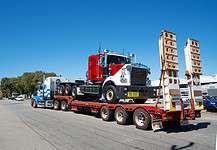All images: WPG Resources
BY ELIZABETH FABRI
SOUTH Australian mine Challenger has been operating for 15 years, but it still has a long and promising future ahead. Under the fresh ownership of WPG Resources, mine life continues to grow through an aggressive exploration campaign which is returning high-grade results, and a two pronged expansion due for completion in early 2018.
Discovered by Dominion Mining in 1995, the Challenger gold find was a huge win for the South Australian resources sector; generating thousands of construction jobs and ongoing jobs for the State.
Dominion Mining began construction in September 2001, open pit mining in 2002, and underground production in 2005.
The mine was later operated under a 50/50 joint venture between Kingsgate and Diversified Minerals, and last year was taken over by WPG Resources.
The project, 730km northwest of Adelaide in the Gawler Craton geological region, now has capacity to process more than600,000 tonnes per annum.
WPG ownership
WPG and PYBAR subsidiary Diversified Minerals bought the mothballed Challenger mine from Kingsgate Consolidated in March 2016 for about $1 million. The operation was restarted in May the same year.
WPG became the 100 per cent owner when its acquired Diversified Mining’s remaining interest in August.
“The mine was bought, and the [Kingsgate] transaction was completed on 15 March 2016,” WPG Resources newly appointed chief executive Wayne Rossiter said.
“The acquisition price was $1 million payable out of cash flow, which has all been paid now, and we restarted the mill on 23 May, re-entered the underground workings on 16 June, and started ramping the mine up from there; so it was a three month ramp up period.
“In that interim period, we entered into a transaction to acquire Diversified Mineral’s interest in Challenger which was completed effective at the end of July and was consummated in August; so we now have a 100 per cent interest in the Challenger Gold mine and all the exploration properties that that relates to.”
This included a 28 per cent interest in the Western Gawler Craton JV managed by Tyranna Resources.
Mr Rossiter said the company’s basis for acquiring Challenger was to reopen the mine and mill and process 30,000 tonnes a month from the underground mine and 20,000t per month from an existing low-grade stockpile.
WPG’s nearby Tarcoola mine was to be mined as a satellite pit with ore sent to Challenger for processing; a decision that saved WPG about $20 million in investment facilities and enabled a higher recovery and certainty for Challenger.
“We broke first rock at the Tarcoola mine in December and trucked our first ore to Challenger in January, poured the first combined bars in February, and have been actively stripping at Tarcoola and mining there since that point in time,” Mr Rossiter said.
“The first couple of benches [were] pretty low grade [as] we were in a depleted zone, but in the month of May we hit the high grade area.
“It’s been performing very well grade wise, once we got through that depleted zone.”
In February, WPG announced the Challenger mine had reached its first major milestone, with one tonne of gold poured since the first pour under WPG ownership in May 2016.

Production results
While mining operations were now in full swing, production ramp up over the last nine months had been a challenge.
“Kingsgate weren’t silly and mined their best stopes before they mined underground, so we did have a number of lower grade stopes to work through,” Mr Rossiter said.
“From an overall cost perspective we were blending our higher grade material from underground with quite a low grade stockpile; that diluted our head grade up to the middle of the March quarter this year.”
Mr Rossiter said its mining contractor PYBAR had struggled to “get development metres” , which forced WPG to mine from outside its original mining plan — which subsequently diluted head grade.
A 12 December announcement advised that mining these lower grade stoping areas would lead to a significant reduction in forecast gold production for the month.
“While underground ore haulage in the year to date at Challenger has been a little in excess of budget, mine development is well behind schedule,” WPG stated at the time.
As a result, PYBAR agreed to mobilise a brand new jumbo development rig at its own expense.
“We’ve seen some improvements starting to come through as a result of that at a number of production faces,” Mr Rossiter said.
“We got squeezed to one stope in December, and now we’re back to five or six.”
“We’re still behind in vertical development; that’s about getting the mine set for this higher throughput and that’s what we’re working on now.
“It will take a couple of quarters for the mine to track back to where it should be.”
In the March quarter, the mine produced 12,406 ounces (oz) of gold, following December quarter production of 12,429oz of gold, with year to date production for the first nine months sitting at 36,973oz.
WPG’s FY17 guidance was between 52,000oz and 56,000oz, which would mean it would need to produce more than 15,000oz in the June quarter to reach the bottom end of the range.
Mr Rossiter said the company expected to still land within the FY17 target.
Expansion plans
With teething issues now behind them, WPG was shifting its attention to a two-stage mine infrastructure expansion to boost productivity.
Mr Rossiter said the company’s plan to process 30,000t per month from underground and 20,000t per month from Tarcoola was going better than expected, with almost 40,000t recovered from underground each month.
“It became very obvious to us that the mill was going to be the bottleneck in the process, so we have been undertaking a study of how we can expand the Challenger mill to accommodate all the ore that we have available,” he said.
“This mill in a prior life has done more than 800,000tpa in duty, and we think we can get the mill up to 700,000t with a minimal capital spend and back to over 800,000t with a very modest capital spend.”
“We’ve actually been running the mill at the equivalent of 700,000t already on an intermittent basis. To be able to sustain that we need to be able to upgrade our water availability, which we are in the process of doing now, and there’s some minor modifications in the plant that are required.”
He said due to the age of the plant, the company needed to introduce some modern instrumentation.
Phase one of the upgrade was estimated to cost $1.5 million and would involve an increase in the water supply, increase in the power of the motor on the second regrind mill, an absorption column and changing the tank screens on the absorption column to enable a higher flow rate.
On 13 June announced a $7.2 million capital raising to fund phase one of the expansion.
“The purpose of this capital raise is to raise funds essentially to put us in a position that we can enact this program,” Mr Rossiter said.
“Specifically the raising will be the $1.5 million for the plant expansion.
“The bulk of the other proceeds raised will be directed back to underground working. It’s a combination of exploration drilling to add to the resource base, and underground development drilling in our new areas, including Challenger Deeps which will be our primary production area, and the M3 structure that we are stoping on now for the first time.”
Mr Rossiter said phase two of the expansion involved adding a tertiary crusher at an estimated cost about $2.7 million, which would be funded out of cash flow.

Extending mine life
WPG’s plan to update resources and reserves would also be a key focus over the next 12 months.
The company has been progressing a number of exploration drilling programs across the project; specifically targeting Challenger Deeps.
“We knew that we would be able to keep mining the Challenger West structure that Kingsgate had mined until late this year,” Mr Rossiter said.
“But the real reason for buying the mine was the unexploited potential of Challenger Deeps.
“About two months ago we reconfigured the ventilation circuit to get enough air to the bottom of the mine so we could run some machines down there and we’ve been drilling down as part of our first exploration program.”
WPG’s current drilling program was to test the M1 and M2 structures below the shears so it could begin planning to accurately exploit the mineralised lenses on each level.
“We’ve completed the first round of drilling and put out results for the first two fans,” he said.
“We’ve got half of those results back which we’ve announced and it’s been very encouraging.”
WPG had also been drilling the M3 structure, which ran in parallel to M1 and M2, and over the last few months returned positive results.
“This M3 structure has potential to add another one and a half to two years of mine life, and below the shear we’re already seeing two to three years in that as well,” he said.
“We’re seeing a combined mine life now based on what is in resource and that exploration target of about four to five years.”
On 1 June, WPG’s updated mineral resource estimate of 343,299oz included a 27 per cent increase in contained gold but excluded recent progress made at the SEZ and M3 shoots, and exploration drilling in Challenger Deeps.
FY18 and beyond
WPG’s principal focus for the next 12 months will be on production at Challenger, extensions to mine life and the two stage expansion project.
“We fully expect to keep adding to the mine life as we drill,” Mr Rossiter said.
“We’ve got three underground drilling rigs that we own; one that hasn’t been in service as it has been rebuilt, and the other two have been working 24/7.
“That third rig will come into service fairly soon and we may actually bring in another contract rig as we crank up our underground drilling once we come out of this raising and hit the go switch on the expansion plant.”
Currently, WPG was spending several hundred thousand dollars each month on drilling alone which was expected to increase further in the coming year.
“We will be increasing that budget once we put that to the board as part of this strategy as we will go from two rigs to three owned rigs plus a contract rig, so we will probably be doubling that budget,” he said.






































